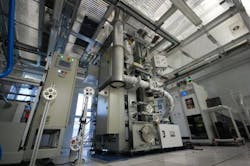Researchers at the University of Southampton (Southampton, England) are set to investigate using additive manufacturing (a form of 3D printing) techniques in the fabrication of optical fiber. The technique could lead to the fabrication of complex structures enabling new applications in a wide range of industries, from biotechnology to aerospace and telecommunications.
Although current techniques used to produce optical fiber preforms give a consistent structure along the length of the preform, they make it difficult to control the shape and composition of the fiber in 3D. This limits the degree of flexibility that engineers can exercise in the design of the fiber and as a consequence, the capabilities that the fibers can offer.
The new technique, which is being developed by Jayanta Sahu together with his colleagues from the University of Southampton's Zepler Institute and co-investigator Shoufeng Yang from the Faculty of Engineering and Environment, will allow engineers to manufacture preforms with far more complex structures and different features along their lengths.
"We will design, fabricate and employ novel multiple materials additive manufacturing (MMAM) equipment to enable us to make optical fiber preforms (both in conventional and microstructured fiber geometries) in silica and other host glass materials," says Sahu. "Our proposed process can be utilized to produce complex preforms which are otherwise too difficult, too time-consuming, or currently impossible to be achieved by existing fabrication techniques."
The making of the preform is one of the most challenging stages of optical fiber manufacturing, especially when the preform has a complex internal structure, such as in photonic-bandgap fiber.
Currently, most microstructured fibers are made using the labor-intensive 'stack and draw' process which involves stacking several smaller glass capillaries or canes together by hand to form the preform.
Preforms made directly from ultrapure glass powder
Instead, using the new additive manufacturing technique, the researchers will be able to form complex fiber structures from ultrapure glass powder, layer-by-layer, gradually building up the shape to create a preform several tens of centimeters in lengths. There are numerous challenges including the high melting temperature of the glass (over 2000˚C in case of silica); the need for precise control of dopants, refractive-index profiles, and waveguide geometry; and the need for transitions between the layers to be smooth, for otherwise the properties of the resultant fiber would be altered.
As part of the project, funded by the Engineering and Physical Sciences Research Council (EPSRC), the researchers will be working with three companies: ES Technology (Oxford, England), a provider of laser materials processing systems; Fibercore (Southampton, England), a supplier of specialty fiber; and SG Controls (Cambridge, England), a manufacturer of optical fiber equipment.
"We hope our work will open up a route to manufacture novel fiber structures in silica and other glasses for a wide range of applications, covering telecommunications, sensing, lab-in-a-fiber, metamaterial fiber, and high-power lasers," says Sahu. "This is something that has never been tried before and we are excited about starting this project."
The project, "Novel Multiple Materials Additive Manufacturing Instrument for New Generation of Optical fibre Fabrication," is funded by the Engineering and Physical Sciences Research Council (EPSRC).
Source: University of Southampton

